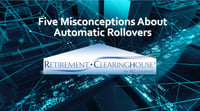 Most agree – automatic rollover programs can help plan sponsors deal with problems associated with small-balance accounts, including:
Most agree – automatic rollover programs can help plan sponsors deal with problems associated with small-balance accounts, including:
- High levels of missing participants
- Increased administrative costs and workload
- Increased recordkeeping fees
- Lower average account balances
Still, misconceptions persist about automatic rollovers.
In the video below, we present five of the most important misconceptions about automatic rollovers that plan sponsors should be aware of.
Misconception #1: It’s best to cash out participants with balances <$1,000
No way. This can produce large numbers of uncashed checks:
- All distribution checks remain a plan asset until cashed.
- The largest single source of uncashed distribution checks is from automatic cash outs of balances <$1,000.
A better approach: Avoid uncashed checks by automatically rolling over balances less than $1,000. Select an automatic rollover provider who accepts balances less than $1,000 into a safe harbor IRA.
Misconception #2: Cashout rates don’t matter for small-balance accounts.
Au contraire. Small-balance cashouts have a huge impact:
- Sub-$5,000 balances represent 28.5% of defined contribution participants, and over 5 million annual job-changing participants.
- A 30-year-old cashing out $1,679 nets $1,175. Had they avoided cashing out, they’d end up with $17,926 at retirement.
- EBRI estimates that plugging leakage for balances under $5,000 has present value benefits of $1.5 trillion, system wide.
A better approach: Improve the odds through education & assistance. Select an automatic rollover provider who discourages cashouts by illustrating the high cost of cashing out, and by assisting participants in consolidating their retirement savings.
Misconception #3: Participants “take charge” of savings in safe harbor IRAs
Nope. A vanishingly small percentage actually will.
- <1% of all safe harbor IRA accountholders will take control and move out of the default investment.
- Despite this, plan sponsors will sometimes agonize over investment options & brokerage features available to safe harbor IRA accountholders.
A better approach: Focus on moving safe harbor IRA balances forward. Select an automatic rollover provider with a solid commitment to moving balances forward. 9 of 10 participants say portability is valuable to them (source: EBRI 2021 Retirement Confidence Survey).
Misconception #4: Miscellaneous automatic rollover fees aren’t important.
Sadly, “miscellaneous” fees can quickly devastate small balances.
- In addition to annual fees and distribution fees, some automatic rollover providers charge:
- Setup fees of up to 20% of the initial balance
-Account closure fees
-Search fees
-Paper statement fees
-Escheatment fees
-….and more, including 275bps default investment fund fees - After two years in a safe harbor IRA, these fees can add up to over $800! Yikes!!
A better approach: Request, in writing, a complete list of all fees.
Misconception #5: A “bundled” automatic rollover service is the best option.
Not always. An automatic rollover service “bundled” by your TPA or recordkeeper may:
- Refuse to accept balances less than $1,000.
- Have extraordinarily high levels of cashouts.
- Pay referral fees to third parties and make these up with miscellaneous fees on your former participants.
- Not support portability and consolidation, and even erect barriers to exit (ex. – signature guarantees).
A better approach: Don’t be limited by “bundled” choices. Select the most fiduciary-friendly automatic rollover option – one that applies an enhanced standard of care for participants.
